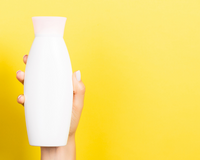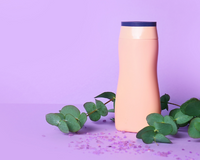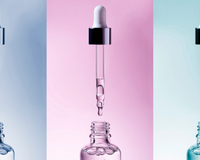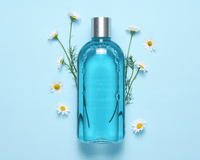Natural hair, which is also known as afro-textured hair, has unique features that can present some hair care challenges and styling challenges. "Natural" hair can also refer to the afro texture that has not been altered by thermal styling or chemical processes such as relaxation. Understanding your hair's natural features and how to work with them rather than against them will make hair care easy.
Understand the Attributes of Natural Hair
Natural hair has unique features that you should know in order to take good care of your hair.
People of African descent usually have curled their hair follicles that produce very tightly curled hair, which can prevent the sebum (a natural moisturizer created by your skin) from saturating to the end of the hair. This can result in dry, brittle hair that is prone to curling and breakage.
Natural hair is prone to knots when combed. Knots also contribute to breakage, so some professionals recommend avoiding combing for this reason. Stay away from combing natural hair when it is dry.
Natural hair often has slower growth than other hair types. In addition, a highly curved hair shaft means that the hair shrinks as it dries; those with very tight or curly hair can see up to 75% shrinkage.
Know Your Hair Type
Natural hair exists in many variants. While many basics of care remain the same regardless of hair type, understanding your hair type can help you determine what hair care and styling routines will produce the desired results.
According to the very widely used hair typing system of famous stylists, there are four basic varieties of hair: straight (1), wavy (2), curly (3), and twisted (4). Within these categories, there are several subcategories, depending on the characteristics of your hair. For example, hair type 4 is generally divided into three subcategories: 4A (spiral curls), 4B (kinky curls), and 4C (curled curls).
Many hair care sites and products refer to hair types using codes, such as "3A" or "4B". The numbers are a reference to the hair type, while the letters refer to the hair texture. Natural hair is usually type 3 (curly) or type 4 (kinky).
Determine the Needs of Your Hair
Understanding your hair sort can help you understand your hair care and styling needs.
Type 3 (curly) hair has sprung, defined curls with lots of volume and body. Curls are usually shaped like coils, loops, or corkscrews. It can be brittle or fine, and for the act of hair care, it needs moisturizing devices and treatments.
Hair type 4 (kinky) has very narrow curls with a lot of volumes. The hair is highly textured, usually tough, and may have multiple curl patterns instead of one dominant one. These patterns often form a "Z" or shrunken appearance. It is the most sensitive hair type because it has fewer cuticle layers than other hair types. A heavy moisturizer and conditioner will help keep hair type 4 healthy.
Cleaning Natural Hair
Detangle before washing your hair. Natural hair is prone to tangles and knots, and washing your hair while it is tangled could damage it. Using hair care moisturizers and untangling combs will help remove knots, braids, and shed hair.
- Pour in a spray bottle one part oil (coconut or olive) with three parts water. Spray your hair until it is thoroughly moisturized.
- Distribute the moisturizing conditioner evenly on wet hair. A lot of conditioners include oils and waxes that make your hair slippery and make it easier to comb without breaking.
- Run your fingers through your hair, feeling for knots and tangles. This will help you avoid attaching them with a comb later. Slightly separate the knots with your fingers.
- Separate the hair into manageable handles. You can gently twist the sections you are not working on or cut them out of the way.
- Use an untangling comb to process each section from end to top. Untangling combs have teeth set at least ½ ”so they won’t tangle so easily in your hair.
Avoid Rough Shampoos
Many shampoos hold chemicals such as ammonium lauryl sulfate, ammonium laureth sulfate, or sodium lauryl sulfate. They create that luxurious lather when you wash your hair, but they can also cause dryness and breakage and are bad for hair care. Look for sulfate-free shampoos that will be gentler on your hair.
There are also shampoo-free cleaning products, such as "cleaning devices," that you can use. They don't lather like a regular shampoo, but it's usually easier on their hair. You can find them in most pharmacies and drugstores.
Avoid Excessive Hair Washing
Natural hair is naturally dry, and washing too often can actually suck moisture out of your hair. Washing once a week is usually enough.
If your hair is greasy more than you would like, try a dry shampoo. These are powder-based washing sprays that absorb excess oil without removing hair follicles. Please don't overdo it, though; dry shampoos are usually removed by brushing, and brushing can also damage natural hair.
Preparing Your Natural Hair for Styling
Use moisturizers that do not rinse. Natural hair needs much more moisture than other hair types to keep it healthy. Still, you don't have to spend a ton of money on conditioners for hair care that don't leave: olive oil, coconut oil, shea butter, and cocoa butter are excellent moisturizers that you can set in your hair after washing and grooming.
It would be best if you avoided thermal style whenever possible. Allow the hair to air dry and avoid using a hairdryer, as wet natural hair by blow-drying means a dangerous combination of high heat and a lot of pulling with the styling brush. Curlers, hot rollers, and hair straighteners are also very heavy on your hair. You can do some things to straighten your hair, such as moisturizing moisturizers for great conditions, but avoid styling with heat whenever you can to avoid breakage.
Prevent Curling with Moisture
This may seem counterintuitive because curling is caused by the suction of moisture from the environment, but hair that is already well hydrated is less likely. Natural oils like coconut oil and olive oil are excellent anti-curling agents, although you can also buy many products to help defeat curls.
Silicone-containing hair care products are especially good at smoothing hair and fighting curls. They can also cause “crunchy” hair, so experiment and see if you like the results.
Sleep on satin to further tangle. Sleeping on a smooth satin pillow or wrapping your hair in a silk scarf before bed is not only a luxurious little pampering but will help keep your hair from getting tangled while you sleep.









